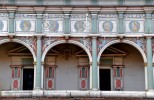- #PL47
- Stary Rynek 25, 61-772 Poznan, Poland
- +48618568193
- mnp@mnp.art.pl
- https://poznan.travel/en/poi/show/id/64
- Working hours*:
Tuesday:09:00 - 15:30
Wednesday:09:00 - 15:30
Thursday:09:00 - 15:30
Friday:10:30 - 20:00
Saturday:10:30 - 17:00
Sunday:10:30 - 17:00 - Prices*:
normal ticket: 7zł
reduced ticket: 5zł - * - opening and closing times as well as entrance prices, are subject to alterations without notice. Visitors are advised to check before visiting.
- Free admission with the Poznań Tourist Card.
- 52.4085630, 16.9341273 Copy to clipboard Copy
-
#Architectural Oddities , #Family time , #Museums
The Gothic town hall was a small one-storey building without a tower that was not added until the early sixteenth century. In the mid-sixteenth century a fire swept through the city and the town hall was partly destroyed. Giovanni Battista Quadro, an Italian architect from Lugano, enlarged the town hall westwards in order to strengthen the tower which was on the verge of collapsing. He also added the three-storey loggia and gave the edifice a Renaissance appearance. Bas-reliefs placed above the arches of the arcades on the first floor represent the virtues desired from councillors: Patience and Prudence, Love and Justice, Faith and Hope and Courage and Moderation. The decoration of the façade also features medallions with ancient figures (above the arcades of the loggia on the first floor) and paintings showing rulers of the Jagiellon dynasty (above the second floor), from the left: Jadwiga, Władysław Jagiełło, Władysław III of Varna, Kazimierz IV Jagiellon, John I Albert, Aleksander, Sigismund the Old and Sigismund Augustus. Portraits of Piast rulers are placed on both sides: Mieszko I, Bolesław the Brave, Przemysł I, Przemysł II, Władysław the Elbow-high and Kazimierz the Great.
The decoration of the remaining façades is far less ornate. The north façade features an inscription starting with the words: Hoc opus artificis Joannis Baptistae Itali... ("This is the work by Giovanni Battista, the Italian...") and a pair of compasses and a square, the symbols of architects. Worthy of notice are the buttresses supporting the tower to the north and the attic that from the east resembles a crenellated wall with three pinnacles. The central pinnacle features a clock above which two tin goats appear every day at noon and horn one another. The first clock mechanism was installed in 1551. Right under it is a cartouche with the letters S (tanisław) A (ugust) R (ex) - the initials of King Stanisław August Poniatowski. The fragment of the tower made from bricks from the early sixteenth century bears witness to the Gothic provenience of the town hall, whereas the cupola surmounted by the Polish eagle (1.8-metre high, 2-metre wingspread) is from the late eighteenth century.
The early Gothic cellars with rib vaults are the oldest part of the edifice. The Grand Vestibule on the first floor (also called the Renaissance Room) ranks among the most beautiful interiors in Poland. The vault of the vestibule supported by two pillars is decorated with depictions of animals, mythological and biblical characters, the Sun, the Moon and planets. The coffers feature the crest of Poznań and the coat of arms of Poland, Lithuania and Polish royal families. The adjoining Royal Room boasts a Renaissance fireplace embellished with the crest of the city. The Courtroom is surmounted by a Renaissance vault from the mid-sixteenth century and features a statue of the last Polish king, Stanisław August Poniatowski (the Commission of Good Order established in his reign contributed to the cleaning of the city which was shattered by natural disasters and the wars that raged in the 17th and 18th centuries; the town hall was also refurbished thanks to its efforts).
The town hall houses now the Museum of the History of the City of Poznań.




